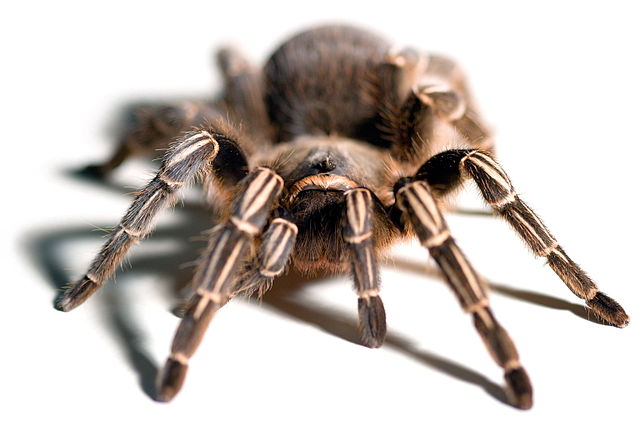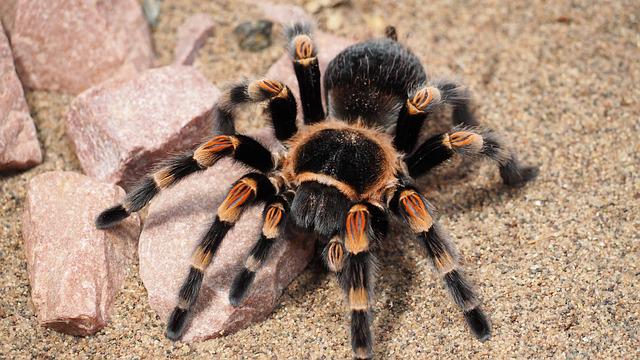Are Tarantulas Aggressive? Are Tarantulas Easy to Pet?
If your busy lifestyle restrains you from keeping high maintenance pets like cats, and dogs, or you just want to enjoy the experience of having a pet without all the care and maintenance required, tarantulas might be the best option for you. Tarantulas are hairy spiders from the Theraphosidae family and have approximately 1000 species. They are extremely low maintenance, require little space, and are interesting to observe.
Are tarantulas Aggressive Or friendly?
Tarantulas are not social animals; they do not like to live in groups or even interact with others of their kind. So, it can be safely assumed that they do not consider humans as their friends. Inherently tarantulas are not aggressive and have no interest in biting their human owners or any human for that matter, but they might do so if they feel threatened in any way. You can have a pet tarantula for years and believe that you share a special bond with your pet, but it might not be the same case with your tarantula. So, it is always advised not to handle a tarantula with bare hands and if you must move one, try to coax it into a container first and then move it to a different location.
This also answers a frequently inquired question about tarantulas, whether they like being petted? The answer is, that as anti-social creatures, they do not like to be held or petted and may think of it as a threat to themselves.
Best species of tarantula to keep as a pet
If you feel like you are ready to have a pet tarantula of your own, you should first consider whether you want a land-dwelling- terrestrial- or an arboreal tarantula, which prefers to live in trees.
Keeping in mind a few major differences between the terrestrial and arboreal types:
1- Terrestrial tarantulas are easier to handle and generally advised for beginners as they have a comparatively calm temperament and are not that aggressive.
2- Arboreal tarantulas are quite aggressive and even professional handlers avoid touching them directly.
3- Terrestrial tarantulas will need a place to dig burrows while the arboreal will require someplace to climb in the enclosure provided.
4- Arboreal tarantulas have longer and thin bodies compared to smaller and bulky bodies of terrestrial tarantulas.
5- Arboreal tarantulas produce comparatively more silk and this might obscure your vision of them; although, the terrestrial tarantulas also, won’t be much better as they tend to create burrows and hide in them.
Best terrestrial tarantulas to keep as a pet:
1- Chilean rose tarantula
These are commonly kept as pets in America. They vary in colors from light brown to rose-tint brown. They are generally chosen as a pet because they are entertaining to observe, moving around anything present in their enclosure including rocks, leaves, etc.
They cost around $20-60.
Average size: 3 inches.
The average lifespan of males: is 5 years.
The average lifespan of females: is 15-20 years.

2- Mexican red knee tarantula
These tarantulas have a vivid red color on their knees giving rise to their name and are the most kept pet among Mexican species of tarantulas. They are generally preferred due to being aesthetically pleasing and because of their longer lifespan.
They cost around $50-100.
Average size: 5 inches
Average male lifespan: 5-6 years
Average female lifespan: 26-30 years.

3- Costa Rican zebra tarantula
They are from a region in Costa Rica and their characteristic white stripes running down their legs is what separates them from other land-dwelling tarantulas. They are docile and adaptable thus a favored species for keeping as pets.
They cost around $20-40.
Average size: 10-13 cm.
The average lifespan of males: is 3-5 years.
The average lifespan of females: is 15-20 years.

Best arboreal tarantulas to keep as a pet:
1- pink toe tarantula
These are quite popular pet tarantulas with pink or orange color at the tip of their legs, also native to Costa Rica. They are docile and have a calm disposition; thus, are generally among the most common arboreal tarantulas kept as pets.
They cost around $20-40.
Average size: 5-6 inches
Average male lifespan: 3-5 years.
Average female lifespan: 10-12 years.

2- Trinidad chevron tree spider
They are quite an aggressive species of tarantula, but they do not possess urticating hair. When they are young, they tend to behave like a terrestrial tarantula and as they age, they move to higher ground. They are quite fast and love a good hiding place.
They cost around $40-50.
Average size: 4-7 inches.
Average male lifespan: 2-3 years.
Average female lifespan: more than 10 years.

3- Sulawesi black tarantula
It is one of the largest tarantulas, and although they are arboreal spiders some of them prefer to build burrows too. After molting they have more of a gray tone to them instead of black.
They cost around $100-150.
Average size: 20-25 cm.
Average male lifespan: 3-4 years.
Average female lifespan: 14-15 years.

Things to consider when choosing a pet tarantula
1. Their bite has venom. They inject this venom into their prey when hunting it so that they can paralyze the prey and then feed on it. Their venom is not lethal to humans and there has never been any death reported because of tarantula’s bite; however, their bite does cause localized pain and swelling in the bitten area which is quite similar to that of a bee sting, with pain lasting for few days and then disappearing without any long-lasting effect.
If a person who is allergic to tarantula venom is bitten, it is advised to seek immediate medical help to avoid having a severe allergic reaction.
2. Tarantulas also have urticating hair on their abdomen, which they scratch off with the help of their hind legs in conditions where they feel threatened. These hairs have sharp tips and possess micro barbs; thus, they can penetrate the skin and cause severe irritations and even inflammation in some cases. If unfortunately, they enter a person’s eyes or other areas like ears and nasal cavity they can cause excruciating pain.
3. When buying a tarantula keep in mind to not buy a pregnant tarantula if you do not plan on having multiple tarantulas to raise.
4. Check whether the tarantula is sick by checking for an inactive demeanor and a curled-up position of the legs.
5. Female tarantulas have a longer lifespan of 20-30 years, compared to the 5-8 year lifespan of males; thus, if you want your pet to keep you company for many years to come, females are advised.
Taking care of pet tarantula
Housing your pet tarantula
1. They do not a need a big enclosure, on the contrary, a smaller container suiting their size and needs is better; because in a large container they will have a hard time catching the live prey being fed to them by their owner and there is the hazard of terrestrial tarantula falling to their death from a high accessory kept in their cage. It has also been observed that tarantulas kept in larger enclosures show symptoms of stress like pacing from one corner to another.
2. For a terrestrial tarantula the length of the enclosure should be able to hypothetically accommodate 3-4 tarantulas the size of your pet, side to side, with the height being about a foot and for an arboreal tarantula, the height of the container should be about 3-4 times the length of your spider’s leg span and length of the enclosure, about afoot.
3. For a terrestrial tarantula, since they like to dig burrows to hide from any predators, you need to provide them with a specific substrate on the bottom of their cage, that may be vermiculite, pet bark, or peat, about 4 inches thick and for an arboreal tarantula, the enclosure should have the stuff to climb on preferably logs or tree bark, nothing sharp or fancy as it may harm the tarantula.
4. Tarantulas are generally found in the warmer regions of the world, including tropical regions, sub-tropic, and arid regions, including deserts. So, if you live in warmer regions of the world you do not require an artificial heating aid for your pet, but if you do live in a colder region, it is advised to use a heating lamp.
5. Some tarantulas, especially the species originating from tropical regions, require a higher humidity level in their enclosure, which can be easily accomplished by misting their container every day.
Feeding your pet tarantula
Tarantulas do not need to be fed regularly. Feeding them once or twice a week is generally enough, although young tarantulas require to be fed more frequently. Tarantulas, like other spiders, live primarily off insects including flies, beetles, crickets, grasshoppers, and even worms like mealworms.
They are nocturnal animals, so they usually stay in their burrows during daylight and come out at night to hunt, so try feeding them in the evening. Since they like to catch their prey; therefore, put the live prey near them with the help of tongs in their enclosure and let them catch it. Also, don’t forget to put water in a shallow container inside the enclosure for your pet.
Taking care of your molting tarantula
Molting is the process through which tarantulas shed their stiff exoskeleton. They molt about every six months as their hard exoskeleton is no longer able to accommodate their growing size. Molting also helps them grow new hair, skin, and even legs if they had lost one previously. The actual process of molting takes about 15 minutes to a few hours.
Although molting is very beneficial for the tarantulas, it is still a very stressful time for your pet and even after molting their new sensitive skin makes them vulnerable. Your tarantula may exhibit a low food intake and a lazy attitude sometime before molting.
For about two weeks, starting from them showing a lethargic attitude to about a week after their molting, you should not feed your tarantula live food, as live insects may hurt your pet.
Some other facts about taking better care of your pet tarantula
1. Never put two tarantulas in one enclosure as being anti-social animals they do not appreciate the company.
2. The enclosure should have holes on the top for ventilation although they should not be so big that your tarantula makes a run for his freedom through them.
3. Tarantulas do not require direct sunlight, nor do they prefer to stay in sunlight so do not keep their enclosure where they are exposed to direct sun.
4. You should aim to change the substrate at the bottom of the enclosure every six months, as regular cleaning or changing is not required.


